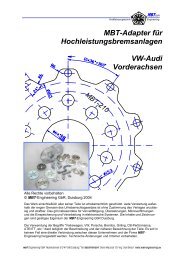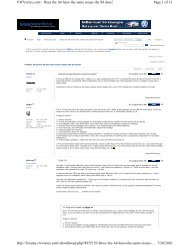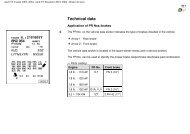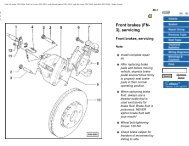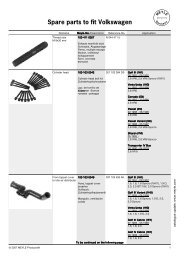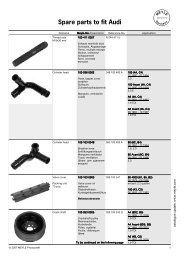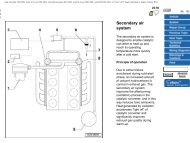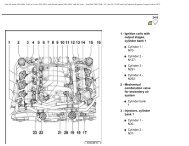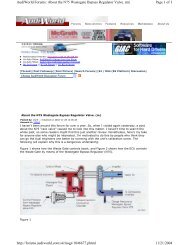VW MKII A2 MK2 Golf Jetta Fox Service Manual - VAGLinks.com
VW MKII A2 MK2 Golf Jetta Fox Service Manual - VAGLinks.com
VW MKII A2 MK2 Golf Jetta Fox Service Manual - VAGLinks.com
You also want an ePaper? Increase the reach of your titles
YUMPU automatically turns print PDFs into web optimized ePapers that Google loves.
2A•4 Engine repair procedures - 1.05 and 1.3 litre pre August 1985<br />
block, connected to the air cleaner by a<br />
rubber hose. Vacuum from the air cleaner<br />
provides a partial vacuum in the crankcase<br />
and the piston blow-by gases are drawn<br />
through the oil separator and into the engine<br />
<strong>com</strong>bustion chambers.<br />
2 Major operations possible<br />
with engine in vehicle<br />
The following operations can be carried out<br />
without having to remove the engine from the<br />
vehicle:<br />
a) Removal and servicing of the cylinder<br />
head, camshaft and timing belt<br />
b) Removal of the flywheel and crankshaft<br />
rear oil seal (after removal of the gearbox)<br />
c) Removal of the sump<br />
d) Removal of the piston/connecting rod<br />
assemblies (after removal of the cylinder<br />
head and sump)<br />
e) Renewal of the crankshaft front and rear<br />
oil seals and the camshaft front oil seal<br />
f) Renewal of the engine mountings<br />
g) Removal of the oil pump<br />
3 Major operation only<br />
possible after removal of<br />
engine from vehicle<br />
The following operation can only be carried<br />
out after removal of the engine from the vehicle:<br />
a) Renewal of crankshaft main bearings<br />
4 Method of engine removal<br />
1 The engine, together with the gearbox,<br />
must be lifted from the engine <strong>com</strong>partment<br />
and the engine separated from the gearbox<br />
on the bench. Two people will be needed.<br />
2 A hoist of 150 kg capacity will be needed to<br />
lift the engine approximately 1 metre. If the<br />
hoist is not portable, then sufficient room<br />
must be left behind the vehicle to push it back<br />
out of the way so that the engine may be<br />
lowered. Blocks will be needed to support the<br />
engine after removal.<br />
3 Ideally the vehicle should be over a pit. If<br />
this is not possible then the body must be<br />
supported on axle stands (see “Jacking and<br />
vehicle support”) so that the front wheels may<br />
be turned to undo the driveshaft nuts. The<br />
left-hand shaft is accessible from above but<br />
the right-hand shaft must be undone from<br />
underneath. Removal of the gearshift linkage<br />
can only be done from underneath, as can<br />
removal of the exhaust pipe bracket. When all<br />
tasks are <strong>com</strong>plete, lower the vehicle back<br />
onto its wheels.<br />
4 A set of splined keys will be required to<br />
remove and refit the socket-head bolts used<br />
to secure certain items, such as the cylinder<br />
head bolts.<br />
5 Draining of oil and coolant is best done<br />
away from the working area if possible. This<br />
saves the mess made by spilled oil in the<br />
place where you must work.<br />
6 If an air conditioning system is fitted,<br />
observe the precautions listed in Chapter 3.<br />
5 Engine - removal<br />
4<br />
1 Disconnect the battery negative lead.<br />
2 Remove the bonnet.<br />
3 Drain the engine coolant and remove the<br />
radiator, <strong>com</strong>plete with cooling fan unit.<br />
4 Remove the air cleaner unit.<br />
5 Loosen the clip and disconnect the top<br />
hose from the thermostat housing.<br />
6 Place a container beneath the engine then<br />
unscrew the sump drain plug and drain the oil<br />
- see Chapter 1. When <strong>com</strong>plete, clean the<br />
drain plug and washer and refit it to the sump.<br />
1081 <strong>VW</strong> <strong>Golf</strong> & Jeta<br />
7 Identify the fuel supply and return hoses<br />
then disconnect them from the fuel pump (see<br />
illustration) and fuel reservoir/carburettor.<br />
Plug the hoses to prevent fuel leakage.<br />
8 Loosen the clip and disconnect the bottom<br />
hose from the coolant pipe at the rear of the<br />
engine.<br />
9 Disconnect the accelerator cable and,<br />
where applicable, the choke cable.<br />
10 Disconnect the heater hoses from the<br />
thermostat housing and rear coolant pipe.<br />
11 Detach the following connections,<br />
identifying each lead as it is disconnected to<br />
avoid confusion on reassembly:<br />
a) The oil pressure switches on the rear<br />
(carburettor side) of the cylinder head<br />
b) Inlet manifold preheating element line<br />
connector<br />
c) Thermo-switch leads (coolant hose<br />
intermediate piece)<br />
d) Distributor HT and LT leads<br />
e) Starter motor<br />
f) Temperature sender unit (thermostat<br />
housing)<br />
g) Fuel cut-off solenoid valve on carburettor<br />
h) Earth strap to gearbox<br />
12 Detach the wiring loom from the location<br />
clip on the bottom hose and fold back out of<br />
the way.<br />
13 Disconnect and unclip the vacuum hoses<br />
from the distributor and inlet manifold as<br />
necessary.<br />
14 Disconnect the clutch cable (see<br />
illustration).<br />
15 Disconnect the exhaust downpipe from<br />
the exhaust manifold.<br />
16 Disconnect the speedometer cable from<br />
the gearbox and place it on one side.<br />
17 Apply the handbrake then jack up the<br />
front of the vehicle and support it on axle<br />
stands (see “Jacking and vehicle support”).<br />
18 Remove the screw from the shift rod<br />
coupling and ease the coupling from the rod<br />
(see illustration). The screw threads are<br />
coated with a liquid locking agent and if<br />
5.7 Detach hoses from fuel pump 5.14 Earth lead (A) and clutch cable (B)



